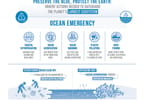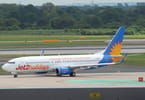INDIA (eTN) – Aviation forms an integral part of any tourism industry. Historically, the greater the number of seats, the higher is the amount of travel to a particular destination. For example, the number of flights from Mumbai to Delhi doubled over the past eight years with seats rarely going empty even during non-peak hours. Predictably, leisure, business travel, and tourism received a boost because of this increase.
Connectivity between far-off places has also improved making places closer to each other in terms of time, than could ever be imagined. Yet almost all domestic airlines reported losses from October to December 2013. The first half of the year doesn’t look too bright either, with distress sales of airline seats being organized almost on a fortnightly basis! On the other hand, we have Emirates requesting DGCA to increase its seat allocation by 20,000 seats each week, effectively paving the way for A-380s to begin their operations to India. Other international airlines will follow in the not-so-distant future. Ignoring the plight of Indian-owned carriers and expecting tourism to leapfrog into the future is like boiling tea in a kettle without a handle!
Historically, over the past fifty years, a handful of airlines weathered the storm. The first forty years saw Air India and Indian Airlines enjoy complete monopoly with healthy annual profits. Under the legacy of JRD, Tata Air India was voted among the top three airlines of the world, along with British Air and Swissair during the sixties. Between the seventies and the eighties, Air India had flight operations to all five continents of the world including far-flung Lagos in Nigeria, Africa, and Perth in Australia. Indian Airlines operated an efficient domestic fleet network across India, including some airports in Northeast India.
The downfall began in the early nineties when competition set in among domestic airlines. Over the next five years all airlines, including East West, Damania (NEPC), and Modiluft shut down shop, leaving just Jet Airways and Indian Airlines in the picture. Professionally-managed Jet Airways brought back the “joy of flying” for domestic flyers, while Indian Airlines managed to hold on partly aided by government funding. While Jet Airways grew by leaps and bounds over the next ten years, Indian Airlines started mounting huge losses. Jet Airways even issued shares at a premium of Rs 1390 for a ten rupee share. Air India began feeling the pressure, too, thanks mainly due to its indecisiveness to increase fleet capacity, mismanagement, overdependence on royalty from overseas carriers for flying into India from destinations Air India didn’t fly to, an inordinately large workforce, and ordinary decision-making.
Mid-2005 to 2010 was the next big phase for domestic airlines to buck the trend of reporting continuous losses. Jet Airways continued its upward trend, although the cracks were beginning to show with increasing and cutthroat competition from Air Deccan, Kingfisher Airlines, and Sahara. Imagine flying for a measly sum of Rs 1 (plus taxes) from point A to point B. Air Deccan did exactly that, giving its airlines tremendous market share, and at the same time it sunk into a financial mess. Sahara, along with Jet and Indian, joined the bandwagon by offering low fares. Not surprisingly, all were left gasping for breath. In a bid to the kill the competition and probably on the advice (?) of consulting houses, Kingfisher grabbed Air Deccan, and Sahara was gobbled up by Jet Airways for huge sums of money. Instead of killing competition, both these airlines were outsmarted themselves, piling in huge amounts of debt and in turn, insurmountable losses.
As is well known in the transportation business, be it of any mode, a successful business needs judicious planning and a strong system of financial checks and balances to report decent profits. Paucity of funds also meant there were negligible amounts left for brand building and visibility across media. A prime reason for the success of professionally-managed Emirates, Lufthansa, and Indigo can be attributed to various publicity campaigns ranging from electronic media to hoardings to radio that are regularly carried by these carriers, besides, of course, punctuality. In today’s challenging times, building brand recall of airlines is as important as creating toothpaste brands.
The current phase began with the arrival of Indigo, Spice Jet, and Go Air providing immense competition to full-service carriers Jet Airways and AirIndia (brought together under one common name after the merging of Air India with Indian Airlines). Not that it did much good – Air India also started streamlining its international operations making New Delhi a hub instead of providing direct flights from major Indian cities to major foreign cities. In fact, many of the airline routes operated during the seventies and eighties did not figure on Air India’s network today.
The African continent does not figure on Air India’s network. Only recently was Australia brought into the picture. A few flights to Europe doesn’t help AI’s image much – not surprisingly, brand recall is slowly fading. Foreign airlines took advantage of this by asking for an increase in seat allocations on a regular basis. By allowing a further 11,000 seat increase on Emirates Airlines and bringing it to 65,000 seats per week, the airlines has delivered yet another telling blow to Indian-owned airlines operating international flights.
It is disheartening to note that over a period of fifty years just about four airlines managed to hold fort during different periods of time – Air India and Indian Airlines for the first thirty five years, Jet Airways for the next ten years, and Indigo until today with a market share of over 25% and by and large profitable over a period of time. A number of reasons can be assigned to failing airlines ranging from irrational pricing, wide fluctuations in exchange rates, increasing fuel prices, humungous taxation (still perceived as a luxury business), unprofessional management, and finally, inability to create and sustain successful brands. Incidentally, professionally-managed Jet Airways (for a long time), and Indigo both have promoters from the travel industry which partly explains that those with the knowledge of this extremely volatile business with low profit margins are able to swim against the tide more effectively than others.
While it’s a feather in the cap for the Indian travel industry and successful example of vertical integration, a number of issues still remain. Is the Indian aviation industry doomed for domination from foreign players? Have Indian enterprise and business houses given up on the idea of starting national airlines? Is it too much work for too little reward that’s dissuading wannabe corporates? Or is it intense global competition and specialization that is acting as a party spoiler (you operate planes, we do the backhouse informatics)? Your guess is as good as mine!
WHAT TO TAKE AWAY FROM THIS ARTICLE:
- As is well known in the transportation business, be it of any mode, a successful business needs judicious planning and a strong system of financial checks and balances to report decent profits.
- Between the seventies and the eighties, Air India had flight operations to all five continents of the world including far-flung Lagos in Nigeria, Africa, and Perth in Australia.
- Air India began feeling the pressure, too, thanks mainly due to its indecisiveness to increase fleet capacity, mismanagement, overdependence on royalty from overseas carriers for flying into India from destinations Air India didn't fly to, an inordinately large workforce, and ordinary decision-making.






















